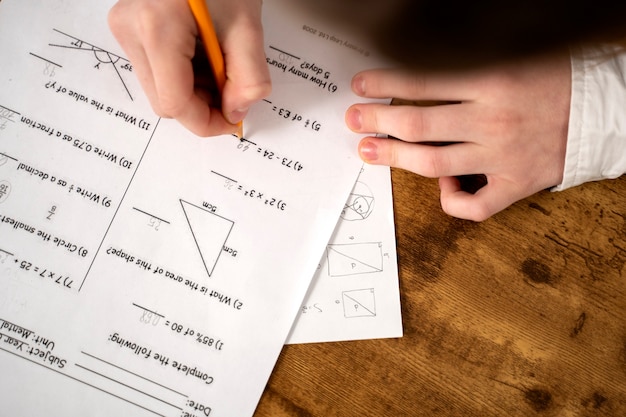
The Evolution of Math Formula Sheets in Education
Over the centuries, the way we teach math has undergone a significant transformation. Initially, in ancient times, mathematics was imparted orally with hands-on demonstrations, seldom relying on written materials. As civilizations progressed, there arose a clear necessity for more organized educational resources, which led to the creation of textbooks and later on, formula sheets. This evolution mirrors larger shifts in teaching methods—from mere memorization to gaining a deeper understanding of mathematical concepts.
A pivotal change occurred during the Industrial Revolution when formal education systems began to take shape. This era saw a concerted effort to standardize school curricula, which included integrating math textbooks into classrooms. These textbooks laid out a structured method for tackling complex theories and problems, serving as crucial reference tools for students.
In our current era, math education is more vibrant and interactive than ever before, thanks largely to technological advancements. Digital tools have revolutionized accessibility, allowing learners to explore mathematics in novel ways that were previously unimaginable. Despite these modern innovations, traditional elements like formula sheets still play a vital role in helping students worldwide grasp essential mathematical equations and principles.
The Transformative Power of Mathematical Notation
The advent of mathematical notation marked a revolutionary era in math education. Prior to the adoption of uniform symbols and equations, navigating the realm of mathematics was notably challenging for both educators and learners. The pioneering efforts by luminaries such as René Descartes and Isaac Newton introduced a universal mathematical language, reshaping instructional methods. This innovation facilitated the creation of structured educational tools like formula sheets, offering students a straightforward approach to deciphering intricate mathematical concepts.
Beyond simplifying educational methodologies, mathematical notation expanded math’s reach across diverse audiences. The adoption of standardized symbols demystified abstract ideas, enabling students to effortlessly connect theoretical knowledge with practical applications. This educational shift led to the widespread use of formula sheets in classrooms globally, serving as essential references that empower students to master complex mathematical challenges with increased confidence.
The significance of mathematical notation in shaping educational frameworks is profound. It established the groundwork for contemporary math curricula and spurred the development of enduring learning resources that continue to benefit learners today. In delving into the evolution of math formula sheets, it becomes evident how crucial notation has been; without this standardized linguistic framework, such pivotal teaching aids would not exist—underscoring their symbiotic relationship within educational progress.
Early Tools in Math Education
Long before the convenience of formula sheets, the landscape of math education was dominated by simpler, yet effective tools such as abacuses and textbooks. The abacus, a venerable device dating back centuries, was instrumental in teaching basic arithmetic. Its straightforward design and practical application made it an essential fixture in classrooms, nurturing students’ foundational math skills.
As educational methodologies advanced, textbooks emerged as the cornerstone of math learning. These books offered expansive explanations and step-by-step examples of intricate mathematical concepts. They acted as conduits from the tactile learning provided by abacuses to the more cerebral challenges posed by formula sheets. Textbooks structured learning experiences meticulously, deepening students’ understanding of mathematics and equipping them for higher academic pursuits.
The evolution from using abacuses to relying on textbooks signifies a dramatic transformation in educational practices for mathematics. This shift not only paved the way for subsequent innovations like formula sheets but also set a precedent for future educational tools. Recognizing these early instruments is crucial as we delve into how formula sheets have revolutionized modern math education.
Integration of Formula Sheets
The introduction of the math formula sheet into educational settings marked a pivotal moment in the teaching of mathematics. Originally deployed as an auxiliary aid, these sheets swiftly became a cornerstone of classroom learning. They offered students a compact guide to crucial equations and principles, enabling them to concentrate on grasping foundational concepts instead of rote memorization.
The adoption of formula sheets was propelled by the necessity for more effective educational tools. As mathematical curricula evolved in complexity, students found themselves in need of a method to quickly reference vital information. Formula sheets answered this call by providing a simplified means to absorb knowledge that enhanced traditional pedagogical techniques. Gradually, they emerged as fundamental resources within math education, assisting learners at various stages.
In contemporary education, formula sheets are vital in helping students adeptly maneuver through mathematical challenges with assurance. They serve as invaluable aids for both educators and learners, promoting an enriched understanding of mathematical theories. The ongoing examination into the development and influence of math formula sheets underscores their lasting effect on educational practices.
Image source: https://www.freepik.com/free-photo/close-up-still-life-hard-exams_23668674.htm
Technology’s Impact on Learning
In the realm of math education, technology has been a game-changer, transforming how formula sheets are used and accessed. The digital age has ushered in an era where students can effortlessly tap into online resources, simplifying the search for crucial mathematical formulas. This digital transformation not only enhances accessibility but also enriches the learning experience with interactive features.
Unlike their paper predecessors, digital formula sheets are equipped with features like clickable links and dynamic equations that draw students into a more engaging mathematical exploration. These innovations enable learners to delve deeper into math concepts, thereby cultivating a deeper understanding of the subject. As technological advancements continue to surge forward, digital formula sheets are poised to expand their capabilities further, opening up new avenues for student interaction with mathematics.
The influence of technology on math education stretches beyond just formula sheets. It has overhauled traditional teaching methodologies by introducing an array of digital tools that make learning mathematics not only more accessible but also significantly more captivating. With resources ranging from online tutorials to interactive simulations readily available, technology is democratizing math education globally. Looking ahead, it is evident that technology will remain integral in driving the future developments of math teaching and learning.
Current Role of Formula Sheets
In the realm of education today, formula sheets have become vital tools that bolster student learning. These sheets are seamlessly woven into educational programs at every level, from the budding minds in elementary schools to the advanced scholars in universities. They serve as essential aids for students grappling with intricate mathematical theories. During exams where standardized testing is the norm, these sheets are handed out to shift students’ focus from rote memorization to adept problem-solving, underscoring their pivotal role in contemporary education.
The introduction of formula sheets into classroom settings profoundly influences learning outcomes. These handy references furnish students with immediate access to crucial formulas and principles, fostering a deeper understanding of mathematical concepts. Beyond mere equation solving, formula sheets are instrumental in advancing educational goals by enhancing critical thinking and problem-solving abilities—key ingredients for comprehensive education.
Despite their prevalent application, the function of formula sheets is continually being refined as educational techniques and technologies advance. Adapting to meet the evolving demands of both learners and teachers alike ensures that formula sheets maintain their relevance in mathematics education across the globe.
Balancing Benefits and Critiques
While formula sheets serve as an essential resource in educational settings, they also face significant scrutiny. Some educators contend that relying too heavily on these aids may impede students from gaining a deep grasp of mathematical concepts. Instead of fostering analytical skills, formula sheets might inadvertently promote rote learning, which could restrict the development of essential problem-solving abilities.
In response to these critiques, educators are actively seeking methods to integrate formula sheets with diverse instructional strategies. By weaving in hands-on activities and real-life examples into lessons, teachers aim to enrich students’ understanding of mathematical principles. This method not only cultivates critical thinking but also enables students to apply their knowledge effectively in various scenarios, thereby enhancing their comprehension and appreciation of the subject.
The debate surrounding formula sheets underscores the importance of a nuanced approach in mathematics education. Merging the practicality of formula sheets with dynamic teaching techniques offers a robust framework for student engagement and learning. Such a holistic strategy ensures that while formula sheets continue to provide essential support, they also contribute to a deeper mastery of mathematics.
Innovations and Future Directions
The landscape of formula sheet design is undergoing a significant transformation, reshaping how students interact with mathematical concepts. Today’s formula sheets are not just static lists; they are becoming dynamic, digital platforms. Features such as interactive equations and clickable resources enrich the learning journey, allowing students to dive deeper into math in a more engaging way.
As we forge ahead, the horizon of formula sheet technology brims with potential. Industry specialists foresee a future where formula sheets integrate cutting-edge technologies like artificial intelligence and virtual reality. This evolution will not only make learning environments more interactive but also highly personalized, setting the stage for a dramatic shift in how mathematical education is approached.
Looking forward, the prospects for formula sheets are luminous, teeming with innovative possibilities brought forth by advancing technologies. Formula sheets are poised to continue their pivotal role in educational landscapes, adapting to cater to both new teaching methodologies and learner requirements. By adopting these advancements, we ensure that formula sheets remain indispensable tools in global math education.
Global Perspectives on Formula Sheets
Around the world, the adoption and integration of formula sheets into educational practices display a fascinating range of diversity. In certain nations, these sheets are fundamental to the curriculum, equipping learners with essential tools to grasp intricate mathematical theories. Conversely, some educational systems employ them more judiciously, focusing instead on nurturing a deeper understanding of mathematical principles.
The cultural backdrop significantly influences how formula sheets are utilized in educational settings. For instance, in societies where memorization is heavily emphasized, formula sheets often become a frequent sight in classrooms. On the other hand, cultures that value critical thinking and problem-solving might introduce formula sheets selectively to enhance students’ capacity to use their knowledge effectively in real-world scenarios.
Regardless of these differences, the influence of formula sheets on mathematics education remains significant. They serve as vital aids for students, facilitating comprehension of complex topics and bolstering their academic growth. As we delve into global perspectives on formula sheets, it becomes evident that they are vital tools in math education globally—empowering students to tackle mathematical challenges with assurance.
Enduring Impact and Future Outlook
The evolution of math formula sheets illustrates their lasting significance in educational realms. Tracing back to their historical roots and examining their present-day utility in classrooms, these sheets have consistently been pivotal in bolstering student learning. They serve as crucial tools for grasping intricate mathematical concepts, thereby fostering critical thinking and enhancing problem-solving abilities.
Looking ahead, the function of formula sheets within educational frameworks is poised for further transformation. As emerging technologies and innovative pedagogical approaches surface, these aids will be tailored to better suit the evolving demands of both students and educators. This continuous adaptation reaffirms the essential role of formula sheets in mathematics education, underpinning student learning and growth.
For educators, the challenge revolves around seamlessly incorporating formula sheets into existing teaching strategies. By striking a balance between traditional methods and the utilization of formula sheets, educators can amplify students’ understanding and mastery of mathematical principles. This strategic integration promises to sustain the relevance of formula sheets in education, equipping students to tackle mathematical challenges with increased assurance.





